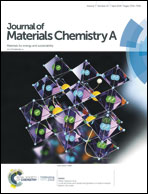Surface P atom grafting of g-C3N4 for improved local spatial charge separation and enhanced photocatalytic H2 production†
Abstract
Improving charge separation efficiency and accelerating surface reaction kinetics are two challenging issues for the graphitic carbon nitride (g-C3N4) photocatalyst. Surface atom decoration is a facile and efficacious strategy to modulate the electronic structure and then affect the local spatial charge separation of the photocatalyst. Here, we first reported a surface P atom grafting strategy for g-C3N4via P–N bond formation to effectively promote the local spatial charge separation and ample reactive sites. The post-calcination process allowed controllable grafting of P–OH at the corner-nitrogen sites in tri-s-triazine of g-C3N4, which resulted in an impurity state, and it acted as an electron capture center for local spatial charge separation and reactive sites. Thus, the surface N–P–OH bond modulation of g-C3N4 rendered nearly four-fold enhancement in the hydrogen evolution rate. The ability to build pure surface P–N motif modulation presents a promising strategy to realize the precise band engineering of modulated g-C3N4. These findings would deepen the understanding of the nonmetal atom decoration-related issues of g-C3N4-based materials.



 Please wait while we load your content...
Please wait while we load your content...